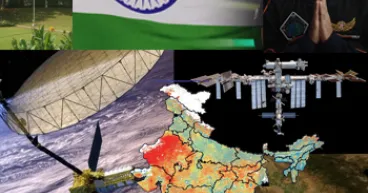Shubhanshu Shukla, inspiring youth in India as the first Indian in space in 40+ years, will oversee science on his Axiom-4 mission to the ISS then look forward to the Gaganyaan human spaceflight program, now approved a budget equivalent to US$2.4 billion with first crewed mission set for 2027 after planned robotic mission later this year. NASA-ISRO Synthetic Aperture Radar (NISAR), launching on a GSLV-F16 from Sriharikota, is called the most expensive Earth-imaging satellite and the 1st dual-frequency synthetic aperture radar.
NASA and ISRO are collaborating on NISAR across 14,500+ km and 13 times zones. With 24-cm L-Band and 10-cm S-band, Earth will be imaged in all weather and at night. Every pass of the satellite will provide an order of magnitude more data than past satellites have delivered, with 2 scans during each pass, every 12 days. An infrastructure is being created to process the expected “fire hose” of data. The antenna reflector is 12 meters wide, yet traditional radar would need a 19-km instrument to get similar images.
ISRO Space Applications Center (SAR) looks to freely provide data, and solicits innovation, technology development, and industry collaboration from Non-Governmental Entities regarding NISAR Operational Science Products that include soil moisture, crops, forests, glaciers, snow, surface water and ocean surface wind speed, garnered from the 2800-kg satellite.
Source: spacecalendar.com
(Image Credits: ISRO, Axiom Space, NASA / JPL-Caltech; Pictured L-R upper: SAR ground antenna, flag of India, S Shukla; L-R lower: NISAR, sample NISAR image of ground moisture, ISS)

16 Jun 2025
India a Leader in Space Ventures with Shukla to ISS and NISAR to LEO
Shubhanshu Shukla is set to become the first Indian in space in over 40 years, leading science operations on the Axiom-4 mission to the ISS before contributing to India’s $2.4 billion Gaganyaan human spaceflight program, targeting a 2027 crewed launch. In parallel, NASA and ISRO are collaborating on NISAR, the most advanced and expensive Earth-imaging satellite, launching from India in 2024. NISAR will deliver unprecedented dual-frequency radar data on environmental conditions such as soil moisture and forest cover. ISRO aims to make this data openly available and is inviting collaboration from non-governmental entities to develop operational science applications.